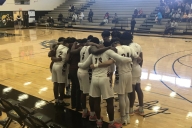You have /5 articles left.
Sign up for a free account or log in.
Tuition at the University of New Mexico has swelled 170 percent in 15 years, with the latest increase coming last month as the Board of Regents approved a new tuition structure that will boost costs 6.6 percent for students taking 15-18 credit hours, and 13.2 percent for those taking fewer than 15.
But the students who are protesting the regents’ decision last month are not focusing on the rise in tuition (though they’re not happy about that, either). Tuition, after all, helps support the academic programs of the university, and students want to find spots in and succeed in those programs. They’re furious that, once again, the regents ignored their formal and solicited recommendation to not increase the fee that students pay to support athletics.
Last month, the regents approved an increase that doubled the student athletics fee in the span of two years, boosting it by $33.45 (following an increase of $50 last year), bringing the per-person expense to $165.20, which will net athletics an additional $900,000 per year.
Both of these changes went against the recommendations of the Student Fee Review Board. That group – which has no legislated say but rather submits its input and lobbies for the best – advocated to keep the fee at its previous level this year.
The students met multiple times with the university president and members of the board, one of whom ultimately voted against the increase, and the board’s finance and facilities subcommittee. Their message, said Marisa Silva, who is president of the Graduate and Professional Student Association, was “please support us.”
Silva said she and her presidential counterpart at the undergraduate level were blindsided by the fee increase. They are furious that fees continue to go up with no apparent regard for student input. (Last year, for example, the regents voted for the $50 increase over spring break, sparking student “outrage,” Silva said. She also said they did not adequately explain the need for this year’s increase or what it would be used for.)
“It’s a recommending body – we don’t have the ultimate authority, I completely understand that the regents have the fiduciary responsibility,” said Silva, who is also vice chair of the review board. But, she added, “People who are constantly struggling because they’re underemployed or unsupported…. The feeling is, overwhelmingly, we can’t shoulder additional fees.”
New Mexico administrators said the fees are necessary for athletics to remain competitive, alluding to what critics call the “athletics arms race” -- the bigger programs spend more to get bigger, and the smaller programs spend more just to keep up.
Not all students are buying that argument, though. Genesea Carter, grants chair of the graduate student association, said the fact that New Mexico’s basketball team just won the Mountain West Conference tournament should be evidence that funding is sufficient.
“We have enough money to get to the conference and win it, and yet they keep raising fees and funneling money,” Carter said. “It just seems to be this runaway train of the administration doing whatever the hell it wants to do.”
The situation at New Mexico is reflective of today’s competitive, commercialized college sports business, said Michael G. Bowen, co-chair of the steering committee for the Coalition on Intercollegiate Athletics, an alliance of faculty senates from Football Bowl Subdivision universities, which house the biggest sports programs.
It’s good that when universities solicit student input on fees, Bowen said, but if the regents are going to outvote them and impose whatever they want, it’s their job to sell the decision. (The students lobbied for and obtained a seat on the board a few years ago.)
“I’m in real sympathy for the students here – it’s a tough situation – but I would suggest that they’re not alone; it’s happening in a lot of places,” said Bowen, a management instructor at the University of South Florida. Part of the problem is that students, faculty members, administrators and trustees aren’t talking to each other about the proper role of athletics.
“That should be a broader conversation at all campuses, not just theirs,” Bowen said. “It hasn’t been enough of a conversation on our campuses.”
Experts said that in most cases, administrators discuss proposed increases with the student government, or a student board member, but not necessarily the general student body.
Like most universities, New Mexico is consistently operating its athletics department at a deficit. (Despite operating revenues in the tens or even hundreds of millions, only about 22 Division I athletic programs turn a profit.)
“Essentially, the business model just has failed to produce enough money. I don’t think our overall expenditures are exorbitant for a Division I school,” said David Harris, executive vice president for administration at New Mexico. “The decision that led to the fee increase was just part of an overall strategy to create some fiscal balance at athletics.”
In 2011, New Mexico athletics collected about $1.8 million in student fees (compared to $1 million in 2006) and $3 million in direct university subsidies, and has a total annual revenue of $40.3 million, according to a USA Today database of athletics department finances. Its operating expenses come in at $40.4 million. Subsidies -- including additional funds from the state and the university -- account for 41.2 percent of revenue.
Harris said New Mexico tries to keep fees at the average level for the university’s peers in the Mountain West conference. Some of those are Boise State University ($3.2 million in fees; 28 percent of total $37.5 million in revenue is subsidized), the University of Nevada ($2.2 million in fees, 44.2 percent of total $22.7 million in revenue is subsidized), the University of Nevada at Las Vegas ($2.8 million in fees, 54.2 percent of total $59.6 million in revenue is subsidized), and San Diego State University ($9.7 million in fees, 40.1 percent of total $45.2 million in revenue is subsidized).
B. David Ridpath, an associate professor of sports administration at Ohio University, conducted a survey this year of students at universities in the Mid-American Conference, where student fees make up a higher percentage of revenue than in any other conference. He found that half of students didn’t know they were paying a fee (many colleges just lump all fees into one large figure on the bill), and those who did didn’t realize how high it was. More than 60 percent of students said they wanted the fee reduced, and wanted to see the figure on their university bill.
Generally, the smaller the institution, the larger the subsidy, and programs in the MAC are smaller than those in New Mexico’s MWC. But Ridpath said his findings are generalizable to any mid-major and some Bowl Championship Series conferences (but not the truly self-sustaining programs). That’s because as costs continue to rise, so does spending and fees – “yet at the end of the day, there’s still only one winner and very few people in the market make money,” Ridpath said.
“These costs are not slowing down, so I think the pushback is going to grow,” Ridpath said. “Eventually, it is going to affect people’s ability to go to school.”
Silva says that’s exactly what’s happening at New Mexico, a Hispanic-serving institution whose students are dealing with a new, more costly tuition structure intended to get students to graduation faster; the state’s full-ride lottery scholarship – which covers tuition but not fees – running out of money; and lingering effects of the economic recession. Six thousand graduate students, many of whom are returning to college or supporting families, are fighting over 1,200 teaching assistant positions, Silva said, and financial issues are the number-one reason why freshmen don’t return to New Mexico in their second semester. (Only 15 percent of New Mexico students graduate within 4 years, and 44 percent do so within six years.)
“I know that $32 on the surface – it’s not an incredibly high amount of money,” Silva said. But any amount can get a hold put on your account if it’s not paid in time, she said.
While Silva says she recognizes the value of athletics, she believes the enterprise is already adequately supported by fees and institutional subsidies.
Government cuts to higher education have affected more than just the academic side – most universities subsidize their athletics programs at least somewhat, and at smaller colleges those subsidies can make up as much as 80 percent of the total sports budget. So when government subsidies get cut, so too do university subsidies – and that money has to be made up somewhere.
Administrators often refer to athletics as “the front porch to the university,” because it’s a visible outreach tool and boosts applications. New Mexico athletics brings “a lot of value” both to the student experience and to the state, Harris said, because it’s about all there is in the area.
“I mean, we have a AAA baseball team,” he said, “and then we have UNM athletics.”
In Ridpath’s survey, more than 80 percent of students said athletics was unimportant in their institution choice. The same amount said athletics was unimportant to the institution as a whole.
The New Mexico fee increases are permanent, but those students are unlikely to go silent. As Carter said, “this has been an ongoing issue for many, many, many years.”








